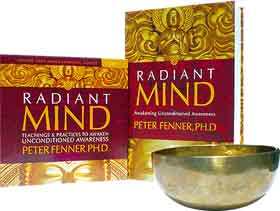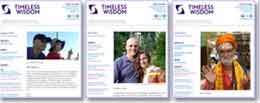In nondual work the focus is on the quality of what is being experienced in this moment. We explain that we can’t get our hands on the past, and the future doesn’t exist. This is the only place we can be. What’s relevant is how we are in this moment. We are learning how to recondition ourselves so that we suffer less. The way to do this is to suffer less whenever we have the opportunity. By suffering less in this moment, the next moment is conditioned to less suffering. So the operative question is: “Is anything missing in this moment?” We look at how to be complete in this moment rather than looking for a strategy or particular resource to use in specific situations in the future. If a student starts to move into the future, wondering about how they are going to integrate the nondual space into their life generally, or how they are going to handle a specific situation using Radiant Mind or nondual resources, I either bring it back to “closing the gap” in this moment, or I move into the mode of talking about general resources that can help in many situations. Examples of this include: expanding our capacity to experience pleasure and pain, not making problems out of problems, and working to be complete in the here and now. I don’t mix these two together—connecting with the here and now, and with general resources—because this can get very messy. In workshops I usually bring it back to the here and now because this is relevant for everyone and there is nothing to misinterpret because we are talking about “being here in the sense of being nowhere.” I am more inclined to work “in time,” at a pragmatic level, in a coaching call where I can tailor what I am saying to the specific circumstances of a student. I sometimes begin talking about general resources and then return to the “now.” I begin “in time” because it can feel more relevant. Going straight to the here and now may produce a disconnection for a student. They can think, “That’s okay now, but I’m not going to be able to do that when X is happening.” So I talk about things that may happen, opening up a small palette of possibilities. Then, having spoken of general resources, I will say, “But of course the most valuable thing for us to do is to connect with this moment, because right now, if we stay ‘here,’ then we will be complete.” So the best thing to practice is “being here,” which we don’t have to do because it’s just happening. If I move directly into the here and now, when I see that a student is “in time,” meaning functioning in past and future, and attempting to sort out the best way to deal with the future, I bring their attention to this, saying, “In nondual work we approach this differently. We don’t work so much in the ‘temporal-causal paradigm’, as this is the paradigm in which we produce something in the future.” I remind them that Radiant Mind is not operating causally, rather we are being in the moment without friction and without incompletion. The term “causal” suggests that what I am doing now is guided by or determined by the particular outcome or consequences I hope will be produced in the future. An example I might want to have a family, because I think I have something to offer and it will be rewarding. Or taking a course because then I will make some significant gain, have insights or realizations. Rather than join the student’s paradigm, we invite them to explore a different possibility.
Listening to the tensing: past, present and future
The way to determine where a student is in time is simply to listen to the verb tenses they are using. If a participant says something like, “I hope I can learn how to release my feelings more easily,” I immediately pick up on hope and the fact that this is something to happen in the future. The speaker is located in time. I think, “Okay, we are in time. The focus is on the future. The relevant feeling is hope.” These things register immediately. If someone says, “I’m frightened about how I’m going to deal with X,” I immediately see that we are not in the type of conversation that’s talking about what’s happening now. We are in time. If I respond to it in this frame of reference, I’ll be in time, too.
Beyond pleasure and discomfort
Nondual awareness isn’t a feeling state. Feelings, like thoughts and sense-data, are objects of awareness, not awareness itself. A full range of sensations can be present within a nondual field, but the field or space itself has no structure. As the Heart Sutra says, in the space of “perfect wisdom, there is no suffering or absence of suffering.” If a student is talking about feeling good, excited, worried, frustrated, etc. they aren’t presencing nondual awareness. They are involved with a feeling state. There is absolutely nothing wrong with this. This is life. But from a nondual perspective it means there is room for movement. There are many, many ways of accessing the nondual. We will look at these in later chapters. If you refer back to the diagram you’ll notice a highlighted semi-circle around the top half of the center point. This is to indicate that there is a domain of positive experiences, experiences of contentment, deep relaxation, pleasure and bliss that can support entry into nondual awareness. If people are located in this region I usually let things be, or I gently point out that this isn’t nondual awareness, rather they are holding onto a conditioned state which will invariably change. You will also notice that there’s a small area in the “egg” beneath the white horizontal line. This area represents mild degrees of discomfort. In many cases I find the low-level discomfort is best worked with by just “letting it be.” The types of discomfort that arise from muscular tension, normal daily concerns, feelings of mild anxiety come and go all the time. If we give them a lot of attention they can increase in intensity. If we normalize such experiences and create space for them to be, they usually dissolve quite quickly. Sometimes people will tell me in a workshop that they have some tension in their shoulder and they would like a nondual way of removing it. I recommend that they stand, stretch, and do some simple exercises to relieve the tension!
Here is a dialog showing how a feeling of mild anxiety self-liberates when there is no resistance
S: I’m feeling uncomfortable. I’m not sure it’s good for me to be here.
P: Is the feeling mild or intense?
S: It’s more than mild but not super intense.
P: I understand.
S: Is there something I can do to make it go away?
P: Another possibility is to let it be there: not to resist it. You could try that. It’s normal for different sensations to arise, particularly in this work which doesn’t support many of our familiar ways of seeing things. You can say to yourself, “Okay, I’m feeling uncomfortable and disoriented. That’s okay. Even if I’m in this space for the next two hours, that’s still okay.” How does that sound?
S: I feel more spacious just taking that in. [Three minutes later, after a conversation with another student, I return to S.]
P: How are you feeling now?
S: Fine. I was completely involved in what you were saying earlier.
The above article is an excerpt from Natural Awakening: An Advanced Guide to Sharing Nondual Awareness



